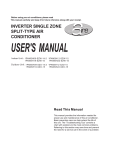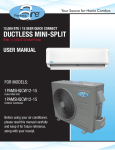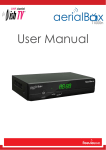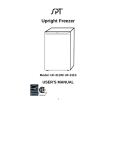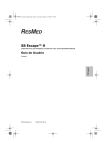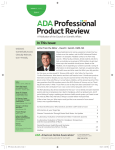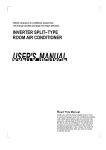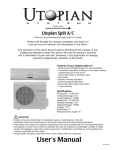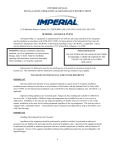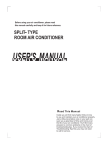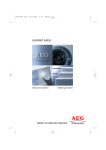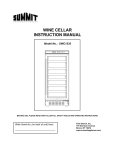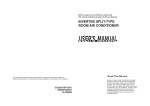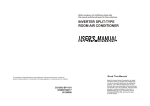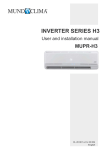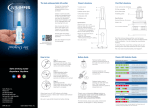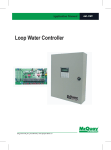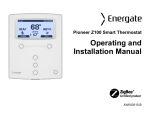Download pamsch 30 36 User Manual
Transcript
Before using your air conditioner, please read this manual carefully and keep it for future reference along with your receipt. INVERTER SINGLE ZONE SPLIT-TYPE AIR CONDITIONER Read This Manual This manual provides the information needed for proper use and maintenance of this air conditioner. Basic preventive care can help extend the life of this unit. The “Troubleshooting Tips” contains a chart with solutions to the most common problems. Referring to this section may save time and prevent the need for a service call in the event of a problem. CONTENTS SAFETY PRECAUTIONS Warning ..................................................................................................................................2 Caution ...................................................................................................................................3 OPERATING INSTRUCTIONS Parts names ...........................................................................................................................4 Operating temperature.............................................................................................................6 Manual operation ....................................................................................................................6 Airflow direction control .........................................................................................................7 How the air conditioner works ...............................................................................................8 CARE AND MAINTENANCE Care and maintenance .........................................................................................................9 OPERATION TIPS Operation tips .......................................................................................................................11 TROUBLESHOOTING TIPS Troubleshooting tips .............................................................................................................13 CAUTION Contact an authorized service technician for repair or maintenance of this unit. Contact the installer for installation of this unit. This appliance is not intended for use by persons (including children) with reduced physical, sensory or mental capabilities, or lack of experience and knowledge, unless they have been given supervision or instruction concerning use of the appliance by a person responsible for their safety. Young children should be supervised to ensure that they do not play with the air conditioner . Installation work must be performed in accordance with national or local wiring standards by authorized personnel only. 1 SAFETY PRECAUTIONS To prevent injury to the user or other people and property damage, the following instructions must be followed. Incorrect operation due to ignoring of instructions may cause harm or damage. The seriousness is classified by the following indications. WARNING CAUTION This symbol indicates the possibility of death or serious injury. This symbol indicates the possibility of injury or damage to property. Meanings of symbols used in this manual are as shown below. Never do this. Always do this. WARNING ! Always ensure effective grounding. No grounding may cause electric shock. ! Disconnect the power if strange sounds, smell, or smoke comes from it. It may cause fire and electric shock. ! ! Do not operate or stop the unit by switching on or off the power. It may cause electric shock or fire due to heat generation. Do not operate with wet hands or in damp environment. It may cause electric shock. Do not direct airflow directly at room occupants. This could cause health issues. ! Always install circuit breaker and a dedicated power circuit. No installation may cause fire and electric shock. Use the correctly rated breaker or fuse. Do not allow water to run into electric parts. Do not open the unit during operation. There is risk of fire or electric shock. It may cause failure of machine or electric shock. It may cause electric shock. Ventilate room before operating air conditioner if there is a gas leakage from anotherappliance. Never drink water drained from air conditioner. Do not disassemble or modify unit. It contains contaminants and could make you sick. It may cause failure and electric shock. It may cause explosion, fire and burns. 2 SAFETY PRECAUTIONS CAUTION ! ! When the air filter is to be removed, do not touch the metal parts of the unit. Do not clean the indoor unit with water. Use only soft cloth or slightly damp cloth. It may cause an injury. Water may enter the unit and degrade the insulation. It may cause an electric shock. An oxygen shortage may occur. Unit and circuit breaker/fuse must be switched off when cleaning. Do not put a pet or house plant where it will be exposed to direct air flow. Use only as intended. Do not clean unit when power is on as it may cause fire and electric shock, it may cause an injury. This could injure the pet or plant. Do not use this air conditioner to preserve precision devices, food, pets, plants, and art objects. It may cause deterioration of quality, etc. Use only a soft cloth to clean the unit. Do not place obstacles around air-inlets or inside of air-outlet. Cleaners or detergents may change the color or scratch the surface of the unit. It may cause failure of appliance or accident. Use caution when unpacking and installing. Sharp edges could cause injury. ! If water enters the unit, turn the unit off and disconnect the power, contact a qualified service technician. ! Periodically check the outdoor installation bracket for damage as necessary. Prolonged exposure to outdoor elements may cause damage to installation bracket causing unit to fall. 3 ! ! Ensure proper ventalation, especially in rooms with a stove or other appliance Turn off the main power switch when not using the unit for a long time. Not doing this may cause failure of product or fire. ! Always insert the filters securely. Clean filter once every two weeks. Operation without filters may cause failure. OPERATING INSTRUCTIONS Parts names Indoor unit Note: The indoor unit you purchased may look like one of the following: Air inlet 2 1 5 6 3 4 Air outlet 7 10 9 8 AUTO COOL DRY 11 HEAT FAN FAN MOD S PEED 12 13 E M Indoor unit 1. 2. 3. 4. 5. 6. 7. 8. 9. 10. 11. 12. 13. Signal receptor Display panel Panel frame Chassis Front panel Horizontal louver Vertical louver (on some models) Air filter (under the panel) Manual control button Remote control holder Remote control Connecting pipe Drain hose (A) Outdoor unit 14. Connecting cable 15. Connective pipe 16. Stop valve NOTE: All the pictures in this manual are for explanation purposes only. Your air conditioner may be slightly different. The actual shape shall prevail. (B) Outdoor unit Air inlet (side) Air outlet Air inlet (rear) 14 15 16 4 OPERATING INSTRUCTIONS LED display panel The display panel of the air conditioner you purchased may look like one of the following: TIMER indicator This indicator illuminates when TIMER program is set “ON/OFF”. Signal receptor Signal receptor Signal receptor Signal receptor AUTO indicator This indicator illuminates when the air conditioner is in “AUTO” operation. (1) OPERATION FREQUENCY indicator This display is separated into five zones. The zones illuminate based on the compressor current operation. For example: high frequency will illuminate more zones. (2) TEMPERATURE indicator A) Usually it displays the temperature settings. When changing the setting temperature, this indicator begins to flash, and stops 20 seconds later. B) It displays the room temperature when the air conditioner is in “FAN” only operation. C) Displays the malfunction code or protection code. (3) DEFROST indicator (For Cooling & Heating models only) This indicator illuminates when the air conditioner starts defrosting automatically or when the warm air control feature is activated in heating operation. (4) CLEAN AIR indication lamp: Lights up when “CLEAN AIR” feature is activated. 5 OPERATING INSTRUCTIONS NOTE: This manual does not include Remote Control Operations, see the <<Remote Control Instruction>> packed with the unit for details. Operating temperature Mode Temperature Room temperature Outdoor temperature Cooling operation 62ºF(17ºC) 32ºF~122ºF (0ºC~50ºC) (5ºF~122ºF/-15ºC~50ºC For the models with low temperature cooling system Heating operation Drying operation 86ºF(30ºC) 50ºF(10ºC) 5ºF~86ºF (-15ºC~30ºC) 32ºF~122ºF (0ºC~50ºC) NOTE: 1. Optimum performance will be achieved within these operating temperatures. If air conditioner is used outside of the above conditions, certain safety protection features might come into operation and cause the unit to function abnormally. 2. Room relative humidity less than 80%. If the air conditioner operates in excess of this figure, the surface of the air conditioner may attract condensation. Please set the vertical air flow louver to its maximum angle (vertically to the floor), and set HIGH fan mode. Manual operation Manual operation can be used temporarily in case the remote control is disabled or maintenance necessary. Front panel Manual control button AUTO/COOL NOTE: The unit must be turned off before operating the manual control button. If the unit is operational, continue pressing the manual control button until the unit is off. 1 Open and lift the front panel up to an angle until it remains fixed with a clicking sound. 2 One press of the manual control button will lead to the forced AUTO operation. If you press the button twice within five seconds, the unit will operate under forced COOL operation. 3 Close the panel firmly to its original position. CAUTION: This button is used for testing purposes only. You should not choose it. To restore the remote control operation, use the remote control directly. 6 OPERATING INSTRUCTIONS Airflow direction control Adjust the air flow direction properly, otherwise, it may cause discomfort or cause uneven room temperatures. Adjust the horizontal louver using the remote control. Adjust the vertical louver manually. To set the vertical air flow (Up--Down) direction Perform this function while the unit is in operation. Use the remote control to adjust the air flow direction. The horizontal louver can be moved at O a range of 6 for each press, or swing up and down automatically. Please refer to the “REMOTE CONTROL OPERATION MANUAL” for details. Range To set the horizontal air flow direction (left - right) Move the vertical louver manually to adjust the air flow in the direction you prefer. IMPORTANT: Before adjusting the vertical louvers, the supply power must be disconnected. For some models, the vertical louver can be adjusted by using the remote control. Please refer to the “REMOTE CONTROL OPERATION MANUAL” for details. Vertical louver CAUTION Range Do not operate the air conditioner for long periods with the air flow direction set downward in cooling or dehumidifying mode. Otherwise, condensation may occur on the surface of the horizontal louver causing moisture to drop on to the floor or on furnishings. Do not move the horizontal louver manually unless it is necessary. Always use the remote control. When the air conditioner is started immediately after it was stopped, the horizontal louver might not move for approximately 10 seconds. Open angle of the horizontal louver should not be set too small, as COOLING or HEATING performance may be impaired due to too restricted air flow area. Do not operate unit with horizontal louver in closed position. When the air conditioner is connected to power (initial power), the horizontal louver may generate a sound for 10 seconds, this is a normal operation. 7 OPERATING INSTRUCTIONS How the air conditioner works SLEEP operation Set Temperature 2ºF/1ºC 7 hours timer off 2ºF/1ºC 1 hour 1 hour Cooling SLEEP operation Set Temperature 7 hours timer off 2ºF/1ºC 2ºF/1ºC 1 hour 1 hour Heating AUTO operation When you set the air conditioner in “AUTO” mode, it will automatically select cooling, heating (cooling/heating models only), or fan only operation depending on what temperature you have selected and the room temperature. The air conditioner will control room temperature automatically around the temperature point set by you. If the “AUTO” mode is uncomfortable, you can select desired conditions manually. SLEEP operation When you push “SLEEP” button on remote control during cooling, heating (cooling & heating models only), or “AUTO” operation, the air conditioner will automatically increase (cooling) or decrease (heating) 2ºF/1ºC per hour for the first 2 hours, then hold steady for the next 5 hours, after that it will switch off. This characteristic maintains both energy saving and comfort in night operation. DRYING operation The fan speed will be automatically controlled under dry operation. During the dry operation, if the room temperature is lower than 50ºF(10ºC) the compressor stops and won’t restart until the room temperature is above 54ºF(12ºC). Optimal operation To achieve optimal performance, please note the following: Adjust the air flow direction correctly so that it is not directly blowing on people. Adjust the temperature to achieve the highest comfort level. Do not adjust the unit to excessive temperature levels. Close doors and windows on “COOL” or “HEAT” modes, or performance may be reduced. Use “TIMER ON” button on the remote control to select a time you want to start your air conditioner. Do not put any object near air inlet or air outlet, as the efficiency of the air conditioner may be reduced and the air conditioner may stop running. Clean the air filter periodically, otherwise cooling or heating performance may be reduced. Do not operate unit with horizontal louver in closed position. 8 CARE AND MAINTENANCE Care and maintenance Cleaning the Grill, Case and Remote Control Turn the system off before cleaning. To clean, wipe with a soft, dry cloth. Do not use bleach or abrasives. NOTE: Supply power must be disconnectd before cleaning the indoor unit. CAUTIONS Filter Handle A cloth dampened with cold water may be used on the indoor unit if it is very dirty. Then wipe it with a dry cloth. Do not use a chemically treated cloth or duster to clean the unit. Do not use benzine, thinner, polishing powder, or similar solvents for cleaning. These may cause the plastic surface to crack or deform. Never use water hotter than 104ºF/40ºC to clean the front panel, it could cause deformation or discoloration. Cleaning the air filter A clogged air filter reduces the cooling efficiency of this unit. Clean the filter once every 2 weeks. 1. Lift the indoor unit panel up to an angle until it stops with a clicking sound. 2. Take hold of the handle of the air filter and lift it up slightly to take it out from the filter holder, then pull it downwards. 3. Remove the AIR FILTER from the indoor unit. Clean the AIR FILTER once every two weeks. Clean the AIR FILTER with a vacuum cleaner or water, then dry it in a cool place. 9 CARE AND MAINTENANCE 4. Remove the Air Freshening Filter from its support frame (on some models). (The optional filters include: Plasma Dust Collector/ Silver Ion filter/Bio filter/Vitamin C filter/3M air purifier filter, etc. The removing and installation methods are slightly different, see the pictures marked 1 and 2 on the left. Clean the air freshening filter at least once a month, and replace it every 4-5 months. Clean it with a vacuum cleaner. Air freshening filter 1 Air freshening filter Do not touch the Plasma Dust Collector Filter within 10 minutes after opening the front panel, it may cause an electric shock. 5. Install the air freshening filter back into position. 6. Insert the upper portion of air filter back into the unit, taking care that the left and right edges line up correctly and place filter into position. Maintenance 2 If you plan to idle the unit for a long time, perform the following: (1) Operate the fan for about half a day to dry the inside of the unit. (2) Stop the air conditioner and disconnect power. Remove the batteries from the remote control. (3) The outdoor unit requires periodic maintenance and cleaning. Do not attempt to do this yourself. Contact your dealer or servicer. Checks before operation Check that the air filter is installed. Check if the air outlet or inlet is blocked after the air conditioner has not been used for a long time. Caution Do not touch the metal parts of the unit when removing the filter. Injuries can occur when handling sharp metal edges. Do not use water to clean inside the air conditioner. Exposure to water can destroy the insulation, leading to possible electric shock. When cleaning the unit, first make sure that the power and circuit breaker are turned off. 10 OPERATION TIPS The following events may occur during normal operation. 1. Protection of the air conditioner. Compressor protection The compressor can't restart for 3 minutes after it stops. Anti-cold air (Cooling and heating models only) The unit is designed not to blow cold air in HEAT mode, when the indoor heat exchanger is in one of the following three situations and the set temperature has not been reached. A) When heating has just started. B) Defrosting is occurring. C) Low temperature heating is occurring. The indoor or outdoor fan stop running when defrosting (Cooling and heating models only). Defrosting (Cooling and heating models only) Frost may be generated on the outdoor unit during heat cycle when outdoor temperature is low and humidity is high resulting in lower heating efficiency of the air conditioner. During this condition air conditioner will stop heating operation and start defrosting automatically. The time to defrost may vary from 4 to 10 minutes according to the outdoor temperature and the amount of frost build up on the outdoor unit. 2. A white mist coming out from the indoor unit A white mist may generate due to a large temperature difference between air inlet and air outlet in COOL mode with an indoor environment that has a high relative humidity. A white mist may be generated due to moisture generated from defrosting process. When the air conditioner restarts in HEAT mode operation after defrosting. 3. Low noise of the air conditioner You may hear a low hissing sound when the compressor is running or has just stoped running. This sound is the sound of the refrigerant flowing or coming to a stop. You can also hear a low "squeak" sound when the compressor is running or has just stopped running. This is caused by heat expansion and cold contraction of the plastic parts in the unit when the temperature is changing. A noise may be heard due to louver restoring to its original position when power is first turned on. 4. Dust is blown out from the indoor unit. This is a normal condition when the air conditioner has not been used for a long time or during first use of the unit. 5. A peculiar smell comes out from the indoor unit. This is caused by the indoor unit giving off smells permeated from building material, from furniture, or smoke. 6. The air conditioner turns to “FAN” only mode from “COOL” or “HEAT” (For cooling and heating models only) mode. When indoor temperature reaches the temperature setting on air conditioner, the compressor will stop automatically ,and the air conditioner turns to “FAN” only mode. The compressor will start again when the indoor temperature rises on “COOL” mode or falls on “HEAT” mode (For cooling and heating models only) to the set point. 11 OPERATION TIPS 7. Dripping water may generate on the surface of the indoor unit when cooling in a high relative humidity (relative humidity higher than 80%). Adjust the horizontal louver to the maximum air outlet position and select HIGH fan speed. 8. Heating mode (For cooling and heating models only) The air conditioner draws in heat from the outdoor unit and releases it via the indoor unit during heating operation. When the outdoor temperature falls, heat drawn in by the air conditioner decreases accordingly. At the same time, heat loading of the air conditioner increases due to larger difference between indoor and outdoor temperature. If a comfortable temperature can't be achieved by the unit, we suggest you use a supplemental heating device. 9. Auto-restart function Power failure during operation will stop the unit completely. For the unit without Auto-restart feature, when the power restores, the “OPERATION” indicator on the indoor unit starts flashing. To restart the operation, push the “ON/OFF” button on the remote control. For the unit with Auto-restart feature, when the power restores, the unit restarts automatically with all the previous settings preserved by the memory function. For some models, the unit is designed with Auto-restart function for the open angle of the horizontal louver. Power failure during operation or pressing the “ON/OFF” button on the remote control will stop the unit completely. When the power restores or pressing the “ON/OFF” button on the remote control again, the unit restarts automatically with all the previous settings including the open angle of the horizontal louver by the memory function. So we strongly suggest that the open angle of the horizontal louver should not be set too small, in case the condensed water forms and drops from the horizontal louver. Press the “AUTO/COOL” button under the front panel and the open angle of the horizontal louver will be restored to the standard angle when the condensed water forms on the horizontal louver. 10. Lightning or a wireless telephone operating nearby may cause the unit to malfunction. Disconnect the unit from the power and then re-connect the unit with power again. Push the “ON/OFF” button on the remote control to restart operation. 11. The protection of outdoor low temperature (on some models) The protection of outdoor low temperature can be activated only in the HEATING mode. The unit will stop operating and display "P3" on the LCD window of the indoor unit when the outdoor temperature is or lower than 5ºF(-15ºC) for one hour, but the indoor unit in this situation can still receive the signal from the remote control. The unit will restart automatically with all the previous settings preserved by the memory function when the outdoor temperature is higher than 11ºF(-12ºC) for 10 minutes and the compressor stops operating for more than one hour, or when the outdoor temperature is or higher than 41ºF(5ºC) for 10 minutes. 12 TROUBLESHOOTING TIPS Troubleshooting Tips If one of the following faults occur, stop the air conditioner immediately, disconnect the power and then connect it again. If the problem still exists, disconnect the power and contact the nearest authorized customer service center. OPERATION indicator or other indicators continue flashing. Trouble Fuse blows frequently or circuit breaker trips frequently. Other objects or water fall into the air conditioner. The remote control won't work or works abnormally. If one of the following code appears on the display area : E0, E1, E2, E3..... or P0, P1, P2, P3...... Malfunctions Cause What should be done? Unit does not Power outage. start Fuse may have blown or a circuit breaker has been tripped. Wait for power to be restored. Replace the fuse or flip the circuit breaker. Battery in remote control may have been exhausted. Replace the battery. The time you have set with timer is incorrect. Wait or cancel timer setting. Unit not cooling Inappropriate temperature or heating setting. Set temperature correctly. For (Cooling/heating "Using remote control" section. models only) room very well while air flowing from the air conditioner detailed method please refer to Air filter is blocked. Clean the air filter. Doors or windows are open. Close the doors or windows. Air inlet or outlet of indoor or outdoor unit has been blocked. Turn off unit. Clear obstructions away first, then restart the unit. Compressor time delay protection has been activated. Wait approximately 3 minutes for compressor to turn on and the unit to begin cooling/heating. If issue has not been corrected, please contact a local authorized dealer or the nearest customer service center. Be prepared to provide detailed malfunctions and unit model. Notes: Do not attempt to repair the unit yourself. Always consult an authorized service provider. 13 2020331A2042
















